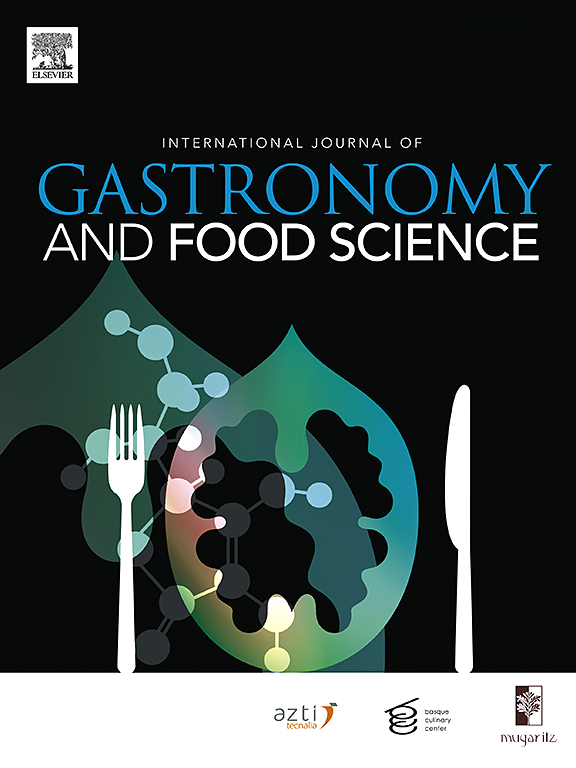má-là风味在葡萄酒饮用过程中的作用:从物理化学的角度寻求葡萄酒和川菜之间的感官和谐
IF 3.2
2区 农林科学
Q2 FOOD SCIENCE & TECHNOLOGY
International Journal of Gastronomy and Food Science
Pub Date : 2025-04-04
DOI:10.1016/j.ijgfs.2025.101178
引用次数: 0
摘要
如今,中国在不同地区普及葡萄酒方面取得了巨大的成功。然而,与西方社会成熟的酒食搭配理论相比,并没有明确的葡萄酒和中餐搭配指南,这无疑限制了葡萄酒在中国餐桌上的享受。川菜风味是世界公认的最具代表性的中国菜风味。本文以川菜中的典型风味Má-Là为例,探讨了葡萄酒和川菜在口腔中的风味分子之间可能存在的相互作用,并讨论了在品尝葡萄酒和川菜时对整体口腔风味感知的潜在影响。本文的背景分为四个部分。第一部分介绍了中国名菜的总体分类及其地域分布和风味特征。第二部分介绍了Má-Là川菜风味,包括风味的描述和来源、影响风味的化学成分和感觉功能机制。第三部分重点阐述了葡萄酒成分对口腔环境的调节作用。最后,提出了葡萄酒与川菜之间交互口腔感官知觉的潜在后果。据我们所知,这是第一次阐述葡萄酒和典型中国美食的风味相互作用的综述,它使读者更好地理解葡萄酒和美食的搭配,或者开发新的特定葡萄酒/美食产品,为消费者在葡萄酒-食品消费过程中提供理想的风味体验。本文章由计算机程序翻译,如有差异,请以英文原文为准。

The role of má-là flavor in contributing desirable oral perceptions during wine drinking: The seeking of sensory harmony between grape wines and sichuan cuisines in a physiochemical perspective
China nowadays has achieved a great success in popularizing grape wine drinking in different regions. However, there are no clear wine and Chinese food paring guides that have been proposed compared with the fully developed wine-food pairing theory in the Western society, which definitely limits the enjoyment of wines on the Chinese dining-table. The Sichuan cuisine flavor is recognized as the most representative Chinese cuisine flavor worldwide. In this review, the typical flavor, Má-Là, in Sichuan cuisines is used as an example to explore possible interactions among flavor molecules within wines and Sichuan cuisines in the mouth and to discuss potential influences on the overall oral flavor perception when enjoy wines and Sichuan cuisines. The context of this review is divided into four parts. The first part presents general categorizations of famous Chinese cuisines and their regional distributions and flavor characters. The second part introduces the Má-Là flavor in Sichuan cuisines, including flavor descriptions and resources, influential chemical components, and sensory functioning mechanisms. The third part focuses on explaining effects of wine components on modifying the oral environment. Finally, potential consequences on the interactive oral sensory perceptions between wines and Sichuan cuisines are proposed. According to our knowledge, this is the first review that illustrates flavor interactions of wines and typical Chinese cuisines, which provides readers better understandings either of paring wines and cuisines, or of developing novel specific wine/cuisine products that offer ideal flavor experiences to consumers during the wine-food consumption.
求助全文
通过发布文献求助,成功后即可免费获取论文全文。
去求助
来源期刊

International Journal of Gastronomy and Food Science
Social Sciences-Cultural Studies
CiteScore
5.30
自引率
10.50%
发文量
170
审稿时长
45 days
期刊介绍:
International Journal of Gastronomy and Food Science is a peer-reviewed journal that explicitly focuses on the interface of food science and gastronomy. Articles focusing only on food science will not be considered. This journal equally encourages both scientists and chefs to publish original scientific papers, review articles and original culinary works. We seek articles with clear evidence of this interaction. From a scientific perspective, this publication aims to become the home for research from the whole community of food science and gastronomy.
IJGFS explores all aspects related to the growing field of the interaction of gastronomy and food science, in areas such as food chemistry, food technology and culinary techniques, food microbiology, genetics, sensory science, neuroscience, psychology, culinary concepts, culinary trends, and gastronomic experience (all the elements that contribute to the appreciation and enjoyment of the meal. Also relevant is research on science-based educational programs in gastronomy, anthropology, gastronomic history and food sociology. All these areas of knowledge are crucial to gastronomy, as they contribute to a better understanding of this broad term and its practical implications for science and society.
 求助内容:
求助内容: 应助结果提醒方式:
应助结果提醒方式:


